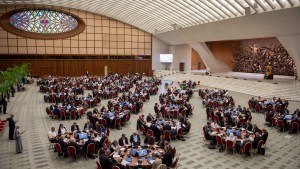The word Catholic has a history that predates Christianity. Its use, however, has evolved over centuries to represent a significant denomination of Christianity. Whereas the use of the term catholic in reference to the Christian Church dates back to the very early days of Christianity, its meaning has developed in parallel with the growth and diversification of the Christian faith. But, for at least 1,000 years, Catholicism was Christianity.
Indeed, nowadays Catholicism is the largest branch of Christianity in the world, with around 1.345 billion adherents around the world – that’s more or less 16.88% of the world’s whole population; in terms of religions it is only surpassed by Sunni Islam, with 22.39%.
A universal faith
The term Catholic is derived from the Greek word katholikos — a word that might mean either “universal” or “according to the whole” (kat holós). In the early days of Christianity, the term was used to emphasize the universality and unity of the Christian faith, irrespective of cultural, geographical, or linguistic differences — that is, according to the whole of Christianity. In that sense, the first recorded use of the term to refer to the community of believers can be traced back to the late 1st and early 2nd centuries, particularly in the works of early Christian writers like Ignatius of Antioch. Ignatius himself used the term to stress the universal nature of the Christian faith and its adherence to apostolic traditions.
The idea of a Catholic Church, which would then represent and comprise the global body of all believers, became increasingly significant as Christianity spread throughout the Roman Empire. The use of the term played a crucial role in distinguishing the Christian faith from various local cults and sects. The First Council of Nicaea in 325 AD, called by Emperor Constantine I, marked a pivotal moment in the history of the term. This council formulated the Nicene Creed, which included the phrase “One, Holy, Catholic, and Apostolic Church,” firmly establishing the term “Catholic” as an identifier for the true Christian Church.
“Catholic” developments
Over time, the Catholic Church emerged as a distinct branch within Christianity, often referred to simply as “the Catholic Church” — that is, it even became synonymous with Christianity as a whole. This development was partly due to the new measures taken by Roman Emperor Theodosius I, who declared Christianity the official state religion in 380 A.D., leading to a rather closer association of the Church and the Roman Empire at almost every level. The title of “Catholic” thus reinforced the Church’s claim to universality.
But, of course, the meaning of “Catholic” within the context of Christianity has evolved further. Today, the term “Catholic” primarily refers to the Roman Catholic Church, led by the Pope and based in the Vatican — in contrast to Protestant churches, whether apostolic or not. However, there are also other Christian denominations, such as the Eastern Orthodox Church and the Anglican Communion, that oftentimes describe themselves as “Catholic” — while maintaining their own distinct traditions and practices. Be that as it may, the word “Catholic” remains an important aspect of Christian terminology, highlighting the enduring quest for unity and universality within the diverse world of Christianity.



